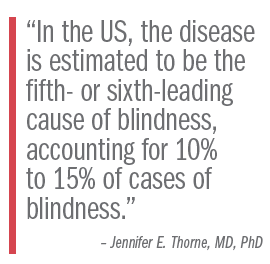Why uveitis is a leading and underestimated cause of visual morbidity in patients
Studies highlight the need for specialists and training programs focusing on the disease.

This article was reviewed by Jennifer E. Thorne, MD, PhD.
For ophthalmologists, increasing the knowledge base about uveitis is important for several reasons.
“Epidemiologic studies of uveitis frame the medical need for uveitis specialists and training programs by defining the disease scope and disease burden and helping to justify research support,” said Jennifer E. Thorne, MD, PhD, director of the Division of Ocular Immunology and Uveitis, and Cross Family Professor of Ophthalmology and Epidemiology, Wilmer Eye Institute, Johns Hopkins University of Medicine and Public Health in Baltimore, Maryland.
Published population-based studies, according to Thorne, detail the burden of visual morbidity, including blindness, societal cost, and loss of quality of life.
During the past 6 decades, 4 major epidemiologic studies have been undertaken by Rochester, Minnesota (1962), the Northwest Veterans Affairs (VA) Centers in Oregon and Washington (2008), and 2 by Kaiser Permanente in California (2004) and Hawaii (2013) that reported the incidence and prevalence of uveitis in the United States. Moreover, Thorne said she believes that the growth of large insurance databases and the IRIS database will result in additional studies.
In the 4 studies, the incidence rates of uveitis increased with age in each of the studies per 100,000 person-years and ranged from 17.4 in Minnesota, 24.9 in Hawaii, 25.6 in the Northwest VA study, and 52.4 in California.
The active prevalence of uveitis in the United States per 100,000 persons also increased with age, except in the Northwest VA study. The prevalence rates were 57.5 and 58.0 in Hawaiian studies (2006 and 2007), 69.0 in the Northwest VA study, and 114.5 in California.
Uveitis rates vary considerably outside the United States; the highest rates were seen in India (730 per 100,000 person-years) and the lowest in Italy (11.4 per 100,00 person-years).
Uveitis impact
Thorne said uveitis is a leading cause of visual impairment.
“In the US, the disease is estimated to be the fifth- or sixth-leading cause of blindness, accounting for 10% to 15% of cases of blindness,” she said.

Studies of uveitis in the Netherlands and India report visual impairment in at least 1 eye in about one-third of cases; in the Aravind group in India, about 1 in 5 affected eyes was blinded by uveitis, but none was affected bilaterally.
The actual rates of blindness and visual impairment may be underestimated because the World Health Organization does not use uveitis as a cause of visual loss, Thorne pointed out. Analysis of the anatomic location of uveitis showed that worsening visual outcomes were seen when the posterior segment was involved.
“Since patients with noninfectious intermediate, posterior, and panuveitis can require chronic regional and systemic treatment compared with only topical drops, much of the morbidity and cost of the uveitis may be attributed to these patients,” she said.
When it comes to cost and care, a 2011 study reported that uveitis has a high socioeconomic
impact that is comparable to diabetic retinopathy in cost. Patients with uveitis, on average, are younger than those with diabetic retinopathy, and the lifetime direct and indirect costs would be expected to be higher among patients with uveitis.1

Thorne and colleagues conducted a study2 in which they retrospectively analyzed the insurance claims of employees in the United States. They considered the uveitis-associated direct costs, defined as inpatient stays, emergency department visits, outpatient visits, and prescriptions, in patients with noninfectious intermediate, posterior, and panuveitis and reported that those patients had twice the number of visits compared with controls, which translated to direct costs of $12,940 compared with $3730. Analysis of the indirect costs, defined as absenteeism from work and disability, indicated that patients with uveitis had 10.3 days of disability compared with 4.6 days for controls and 18.7 days lost from work compared with 8.4 days for controls, which translated to a cost of $3144 compared with $1378.
The caveat regarding the results is that cases of anterior uveitis were not included in the analyses, nor were patients with uveitis who were unemployed or who had insurance through Medicaid or Medicare, for example. Thorne concluded that population-based studies show varied estimates of the incidence and prevalence rates of uveitis in the United States and internationally.
“Uveitis appears to increase with increasing age in most studies,” she said. “Visual morbidity is significant in patients with uveitis but may be underreported because uveitis is often not listed as a cause of visual loss in global assessments of blindness.”
References
1. De Smet MD, Taylor SRJ, Bodaghi B, et al. Understanding uveitis: the impact of research on visual outcomes. Prog Retin Eye Res. 2011;30(6):452-470. doi:10.1016/j.preteyeres.2011.06.005
2. Thorne JE, Skup M, Tundia N, et al. Direct and indirect resource use, healthcare costs and work force absence in patients with non-infectious intermediate, posterior or panuveitis. Acta Ophthalmol. 2016;94(5):e331-e339. doi:10.1111/aos.12987
Jennifer E. Thorne, MD, PhD
e: jthorne@jhmi.edu
Thorne has no financial interest in this subject matter.
Newsletter
Keep your retina practice on the forefront—subscribe for expert analysis and emerging trends in retinal disease management.